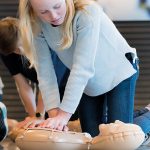In the fast-paced world of healthcare where every second counts, the importance of pediatric resuscitation can't be overstated. This was the central theme of the recent Heart Month webinar "Creating a Culture of Pediatric Resuscitation Excellence," where leading experts provided essential insights for healthcare professionals and the general public. Here's a recap of some of the most compelling points shared during the virtual session.
Fostering a Nation of LifesaversTM
Dianne Atkins, professor of pediatrics at the University of Iowa and chair of the American Heart Association®'s (AHA®) Science Subcommittee of the Emergency Cardiovascular Care Committee, addressed the gap in CPR education and emphasized the need for action. "Seventy percent of Americans feel helpless in a cardiac emergency, and therefore we have a nation of bystanders who don't know what to do," she said. "We want to transform this into a nation of lifesavers."
Highlighting the AHA's impactful initiative, Atkins described the Nation of Lifesavers program's mission. "The long-term goal of this program is to ensure that in the face of a cardiac emergency, anyone anywhere is prepared and empowered to perform CPR and become a vital link in the chain of survival," she noted.
The program's immediate goal, to be achieved by 2030, is to double the survival rate from sudden cardiac arrest. The program focuses on education, advocacy, access to automated external defibrillators (AEDs), national campaigns for CPR training, and building alliances and community support.
Recognizing AEDs as Lifesaving Tools
Atkins also shared AEDs' transformative impact in cardiac emergencies involving children.
The AHA has recommended the use of AEDs in children since around 2005, marking nearly 20 years of endorsement. However, despite this, AED use in children remains low, partly due to the misconception that children's cardiac arrests primarily stem from respiratory issues rather than cardiac rhythm abnormalities.
Atkins referenced recent data from the CARES Registry and a large Japanese registry to highlight AEDs' efficacy in pediatric out-of-hospital sudden cardiac arrests. Survival rates improved among children ages 1 to 17 when AEDs were used, with relative risk ratios indicating a significant increase in survival chances. For adolescents specifically, there was a 12-fold improvement. Moreover, the research found that combining CPR and AEDs led to even better outcomes compared to CPR alone, emphasizing the importance of AED availability and usage in pediatric cardiac emergencies.
"What we can take from this is that if an AED is available and a child has suffered a cardiac arrest, it is appropriate to put an AED on them and follow the instructions of the AED," Atkins said.
Using Bicarbonate With Caution
Atkins cautioned against routine bicarbonate administration in pediatric resuscitation. Bicarbonate can cause harm, especially in cases of respiratory acidosis where improving ventilation efficiency is the primary goal.
"If your patient is acidotic, it's most likely a respiratory acidosis, and what you need to do is improve the ventilation efficiency at that point," Atkins explained. "But I really would encourage you not to give bicarbonate because it's a harmful drug."
Atkins pointed to a 2021 comprehensive review that revealed a concerning trend: While bicarbonate was administered in about 50% of all sudden cardiac arrests from 2010 to 2018, the odds ratio of survival with bicarbonate was notably lower than without it, indicating a 40% increased risk of mortality associated with bicarbonate use. So, bicarbonate should be avoided unless specifically indicated for conditions like toxidrome or hyperkalemia, as its routine use can be detrimental and potentially harmful to patients.
Empowering Healthcare Teams With Training Simulations
Lynda Knight, director of the Revive Initiative for Resuscitation Excellence at Stanford Children's Health, complemented Atkins' comments by noting that training simulations are a cornerstone of effective healthcare staff education.
Knight highlighted the power of the Revive Initiative for Resuscitation in preparing healthcare teams for real-life scenarios through comprehensive simulations. She emphasized the value of interprofessional training, where teams practice together in realistic scenarios. This has helped promote effective communication, role clarity, and timely interventions, bridging the gap between theory and practice.
Knight noted additional learning benefits of the Revive Initiative for Resuscitation, including:
- Practice in real patient rooms with genuine equipment and medications
- Emphasis on familiarity and readiness in emergencies
- Authentic adrenaline rush and dynamic environment in simulations
- Drills recorded for thorough debriefings and learning
- Inclusion of simulated family members for emotional realism
- Positive impact on grieving processes in worst-case scenarios
"We work in teams. We needed to train in teams, so I didn't want it to be nurses over here, residents over there," Knight noted. "Overhead codes were conducted about twice a month. People did not know that they were a simulation until they arrived. And when we collected the data after one-year post-intervention, we actually showed a survival discharge increase by 51%."
Answering Questions About Pediatric Resuscitation
Attendees submitted questions that the speakers answered during the webinar. Here are the answers to two of the questions discussed.
How can I stay up to date with the latest guidelines, science and research in pediatric resuscitation? Where do you suggest I begin?
Atkins suggested staying up to date with the following journals:
What about epinephrine dosing? Is it best to keep the epinephrine dosing to every three minutes? And then what dosing range based on weight is best?
Atkins explained the current recommendation for epinephrine dosing during resuscitation is every three to five minutes. However, some data suggests that early in the resuscitation event, the interval should be reduced to two minutes. She provided the following guidance:
- Aim for a dosing interval of two to three minutes, especially for the first several doses, which aligns with guidelines.
- The standard dose of epinephrine is 0.1 milligrams per kilogram.
Interested to learn what else was discussed during the insightful session? Watch the exclusive on-demand webinar Creating a Culture of Pediatric Resuscitation Excellence.









